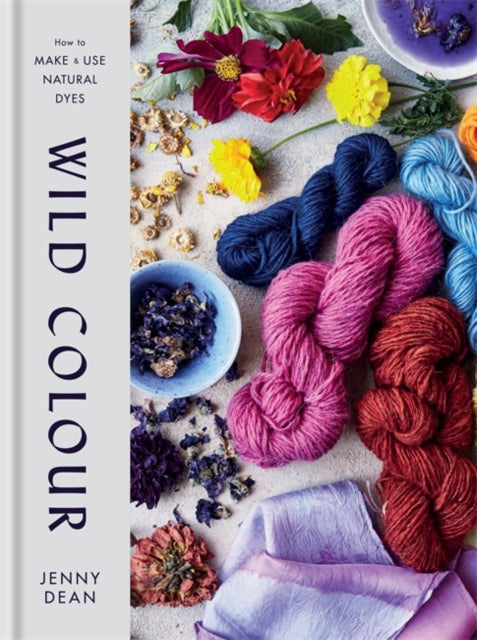Jenny Dean
Wild Colour: How to Make and Use Natural Dyes
Wild Colour: How to Make and Use Natural Dyes
YOU SAVE £5.72
- Condition: Brand new
- UK Delivery times: Usually arrives within 2 - 3 working days
- UK Shipping: Fee starts at £2.39. Subject to product weight & dimension
Bulk ordering. Want 15 or more copies? Get a personalised quote and bigger discounts. Learn more about bulk orders.
Couldn't load pickup availability
- More about Wild Colour: How to Make and Use Natural Dyes
This book provides information on current environmentally friendly dyeing techniques and over 65 species of plants and natural dyestuffs for creating beautiful colors from fibers and plant parts. It is a valuable resource for fiber enthusiasts, sewers, weavers, gardeners, and eco-conscious DIYers interested in using traditional dye plants and learning about the natural dyeing process.
\n Format: Hardback
\n Length: 144 pages
\n Publication date: 06 December 2018
\n Publisher: Octopus Publishing Group
\n
This practical and inspiring guide to creating and using natural dyes from plants offers comprehensive information on current environmentally friendly dyeing techniques and over 65 species of plants and natural dyestuffs. The book provides step-by-step guidance on selecting fibers and plant parts, choosing the appropriate methods for mordanting and dyeing, and achieving a range of gorgeous colors from various plants. Whether you are a fiber enthusiast, sewer, weaver, gardener, or eco-conscious DIYer, Wild Color is the ultimate resource for learning about the natural dyeing process and the plants that are essential for it.
Selecting Fibers and Plant Parts:
The first step in creating natural dyes is selecting the right fibers and plant parts. Different plants produce different colors, and each fiber has unique properties that can affect the dyeing process. Some common fibers used in natural dyeing include cotton, wool, silk, linen, and hemp. Each fiber has its own specific mordanting requirements, which involve treating the fiber with a chemical agent to help the dye bind to it. Mordanting can also help to enhance the color of the dye and improve its durability.
Choosing the Right Methods for Mordanting and Dyeing:
There are several methods for mordanting and dyeing natural fibers. Some common methods include hot water mordanting, cold water mordanting, and chemical mordanting. Hot water mordanting involves soaking the fiber in hot water with a mordant agent, such as alum or copper sulfate. Cold water mordanting involves soaking the fiber in cold water with a mordant agent, such as iron sulfate or tannic acid. Chemical mordanting involves using a chemical agent, such as vinegar or salt, to mordant the fiber.
Obtaining a Range of Gorgeous Colors from Every Plant:
Natural dyes offer a wide range of colors and shades. Each plant has its own unique chemical composition, which can produce a variety of colors. Some common colors produced by natural dyes include blue, green, yellow, red, and purple. To obtain a range of gorgeous colors from every plant, it is important to experiment with different mordanting agents and dyeing techniques.
Wild Color:
Wild Color is a comprehensive book that provides authoritative information about the natural dyeing process and the plants that are essential for it. The book is written by a fiber artist and natural dyer who has years of experience in creating natural dyes. Wild Color covers topics such as:
Selecting Fibers and Plant Parts:
The book provides detailed information on selecting the right fibers and plant parts for natural dyeing. It discusses the properties of different fibers and plant parts and explains how to choose the ones that will produce the desired colors and effects.
Choosing the Right Methods for Mordanting and Dyeing:
Wild Color outlines several methods for mordanting and dyeing natural fibers. It explains the advantages and disadvantages of each method and provides step-by-step instructions on how to perform each technique.
Obtaining a Range of Gorgeous Colors from Every Plant:
The book offers comprehensive guidance on obtaining a range of gorgeous colors from every plant. It discusses the chemical composition of different plants and explains how to mordant and dye them to achieve a variety of colors.
Conclusion:
Natural dyes are a sustainable and eco-friendly alternative to traditional chemical dyes. They offer a wide range of colors and shades and can be used to create beautiful and unique textiles and garments. This practical and inspiring guide to creating and using natural dyes from plants provides comprehensive information on current environmentally friendly dyeing techniques and over 65 species of plants and natural dyestuffs. Whether you are a fiber enthusiast, sewer, weaver, gardener, or eco-conscious DIYer, Wild Color is the ultimate resource for learning about the natural dyeing process and the plants that are essential for it.
\n Weight: 698g\n
Dimension: 267 x 200 x 18 (mm)\n
ISBN-13: 9781784725532\n \n
This item can be found in:
UK and International shipping information
UK and International shipping information
UK Delivery and returns information:
- Delivery within 2 - 3 days when ordering in the UK.
- Shipping fee for UK customers from £2.39. Fully tracked shipping service available.
- Returns policy: Return within 30 days of receipt for full refund.
International deliveries:
Shulph Ink now ships to Australia, Belgium, Canada, France, Germany, Ireland, Italy, India, Luxembourg Saudi Arabia, Singapore, Spain, Netherlands, New Zealand, United Arab Emirates, United States of America.
- Delivery times: within 5 - 10 days for international orders.
- Shipping fee: charges vary for overseas orders. Only tracked services are available for most international orders. Some countries have untracked shipping options.
- Customs charges: If ordering to addresses outside the United Kingdom, you may or may not incur additional customs and duties fees during local delivery.


